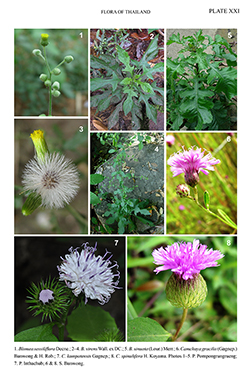e-Flora of Thailand
Volume 13 > Part 2 > Year 2016 > Page 230 > Compositae (Asteraceae) > Blumea
22. Blumea virens Wall. ex DC.wfo-0000008474
in Wight, Contr. Bot. India 14. 1834; Prodr. 5: 439. 1836; Hook.f., Fl. Brit. India 3: 264. 1881; Kerr, Fl. Siam. 2(3): 264. 1936; Randeria, Blumea 10:272. 1960; Gagnep., Fl. Indo-Chine 3: 536. 1924; Grierson, Revis. Handb. Fl. Ceylon 1: 173. 1980. Fig. 29; Plate XXI: 2–4.
Accepted Name : This is currently accepted.
Synonyms & Citations :
Description : Annual herb, 0.1–1 m tall; stem erect with long pilose hairs and glandular hairs. Leaves petiolate, blade elliptic, lyrately lobed with obovate terminal lobe and broadly triangular to oblong lateral lobes, 3–38 by 0.7–15 cm, apex acute, base attenuate, margins serrate, thinly papyraceous, bright green, upper surface glabrate with sparsely hairs, lower surface pubescent with pilose hairs, upper leaves and inflorescence bracts sometimes elliptic or ovate, not-lyrate; petioles 0.5–1 cm long or absent. Inflorescences terminal and/ or axillary, large, loose panicles, 10–45 cm long. Capitula narrowly cylindrical, 3–5 mm diam., peduncles 3–15 mm long; involucres tubular; phyllaries 5-seriate, outer lanceolate densely pilose hairs, apex acute; receptacle 3–4 mm diam., convex, alveolate, glabrous. Marginal floret corollas yellow, basal tube 2.8–4.5 mm long, lobes generally glabrous. Disc floret corollas yellow, basal tube 3–5 mm long, glabrous, lobes oblong-lanceolate, 0.4–0.5 mm long, pubescent with unicellular and glandular hairs, anthers 1.4–1.5 mm long, apical appendages emarginate, bases with unbranched tails, anther-tails equal to, or longer than anther collars; style arms 0.5–0.8 mm long, base swollen. Achenes elliptic, 6–10-ribbed, 0.5–1.1 mm long, setuliferous; pappus bristles 10–15, 3–4 mm long, persistent, white.
Thailand : NORTHERN: Chiang Mai (Mae Ya Falls, Doi Chiang Dao); NORTH-EASTERN: Phetchabun (Kaeng Sopha Falls, Thung Salaeng Luang NP), Loei (Phu Kradueng); EASTERN: Nakhon Ratchasima (Khao Yai NP), Mukdahan (Phu Mu Forest Park, Nikhom Khamsoi); SOUTH-WESTERN: Kanchanaburi (Khao Laem Dam, Thong Phaphum to Pilok, Sai Yok Yai Falls); CENTRAL: Lop Buri, Saraburi (Sam Lan), Nakhon Nayok (Nang Rong Falls), Krung Thep Maha Nakhon (Bangkok); SOUTH-EASTERN: Rayong (Khao Chamao NP), Chanthaburi (Khitchakut NP), Trat (Ko Chang); PENINSULAR: Ranong (La-un), Phuket (Khao Phra Thaeo WS).
Distribution : China (Yunnan), India, Bhutan, Nepal, Pakistan, Myanmar, Laos, Vietnam, Malaysia (Peninsular), Indonesia (Java), the Philippines (Culion, Luzon, Mindanao), Fiji.
Ecology : Moist sandy soils in dry evergreen forests or bamboo thickets, by rocky streams, 50–1,400 m alt. Flowering: December–March.
Vernacular : Nat noi (หนาดน้อย)(Udon Thani, Northern).


